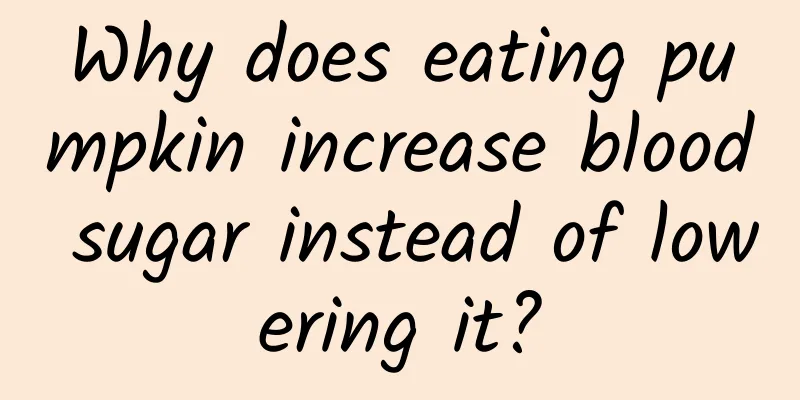Why does eating pumpkin increase blood sugar instead of lowering it?

|
It's pumpkin season again. Pumpkins are soft, sweet, and some varieties can replace staple foods such as rice and flour. Pumpkins are rich in nutrients, and some people say that eating pumpkins can lower blood sugar. In fact, if pumpkins are not eaten correctly, blood sugar will rise instead of lowering it. So, what are some other misunderstandings about eating pumpkins? Myth 1: Eating pumpkin can lower blood sugar This statement comes from animal experiments showing that pumpkin polysaccharides can lower blood sugar, but this does not directly lead to the conclusion that "eating pumpkin can lower blood sugar". First, there are differences between species, and animal experiments cannot be directly applied to humans; second, people eat pumpkins instead of pumpkin polysaccharides. In addition to pumpkin polysaccharides, pumpkins also contain a lot of starch that raises blood sugar, so eating too much will not only not lower blood sugar, but will raise blood sugar. Myth 2: People who are trying to lose weight cannot eat pumpkin In terms of taste, pumpkins are divided into "vegetable pumpkin" and "staple pumpkin". "Vegetable pumpkin" has a high water content and is suitable for cooking and porridge. This type of pumpkin is not high in energy, with an energy of about 23 kcal per 100 grams, which is similar to the energy of water spinach, white radish, bitter melon, and loofah, so those who are losing weight can eat it without worry. "Staple food pumpkin" has low water content, a soft and chewy texture, and a light chestnut flavor, making it suitable for steaming. The Beibei pumpkin and Xinjiang noble pumpkin on the market belong to this category. Their energy is similar to that of potatoes and can replace some staple foods. Myth 3: People with diabetes cannot eat pumpkin Pumpkin is a high GI food. The glycemic index of pumpkin (squash, pumpkin) is as high as 75, which is comparable to rice and white bread. However, compared with GI, glycemic load (GL) takes into account the amount of available carbon water and the amount eaten, and can better reflect the impact on blood sugar. After calculation, it can be seen that the GL of eating 100 grams of pumpkin is 3.4, and GL ≤ 10 is a low glycemic load. In other words, you don’t have to worry too much about a surge in blood sugar after eating 200 grams of pumpkin. Therefore, if diabetic patients like to eat pumpkin, they can replace part of the staple food and eat less, but it is best not to exceed 200 grams. Myth 4: Eating pumpkin will make your skin yellow When it comes to pumpkin nutrition, beta-carotene must be mentioned. The appetizing golden color of pumpkin comes from it. It can be converted into vitamin A in the body, relieving eye fatigue and dryness, which is very suitable for office workers who use their eyes a lot. In addition, vitamin A can also maintain the integrity of epithelial cells. The skin is made of epithelial cells. The skin is particularly prone to dryness in autumn and winter, and a lack of vitamin A will aggravate the dryness of the skin. Therefore, you can eat more pumpkin in autumn and winter. However, if you eat pumpkin every day, the excessive beta-carotene in pumpkin will not be used up temporarily, and it will easily deposit on the skin, causing the skin to turn yellow. However, if you stop eating foods rich in beta-carotene for a period of time, the skin color will return to normal, so there is no need to worry too much. Pumpkin can be fried, steamed, stewed, or boiled. It can be made into millet pumpkin porridge, stewed pumpkin, pumpkin vegetable cakes, steamed pumpkin, oatmeal pumpkin porridge, pumpkin bean paste buns, etc. Steaming pumpkin has the least loss of β-carotene, while frying it has the least loss of vitamin C. (The author is a director of the Capital Health Nutrition and Gourmet Society and a registered dietitian) |
<<: Pay attention to pain and protect health
>>: Hawthorn: a medicinal and edible fruit
Recommend
Is ginger juice and brown sugar effective in regulating menstruation?
Many female friends will feel lower abdominal pai...
Can pregnant women use iodine to disinfect wounds?
After pregnancy, pregnant women need to pay atten...
What is wrong with left lower abdominal pain during strenuous exercise?
There are many things to pay attention to during ...
What causes spots on the chest?
Chest spots are a type of condition that occurs i...
Hangzhou reported that many primary school students tested positive for COVID-19! How to protect yourself during this period?
On February 19, according to Chao News and Zhejia...
Can I do ovarian maintenance if I have uterine fibroids?
In today's high-pressure life, more and more ...
What should women pay attention to when they are first
First pregnancy The first-born child is the smart...
Why is my private part painful and itchy?
I believe many people know that due to the develo...
Eight places where women are most afraid of cold
Women have poorer blood circulation, so they are ...
Are multiple breast nodules serious?
Female friends all hope that their breasts are he...
How many months of pregnancy should I have?
As we all know, we will do a lot of examinations ...
There is a pus spot on the nipple during breastfeeding
We all know that lactation is a very important pe...
What to do if your child has eczema during breastfeeding
Many women are very concerned about breastfeeding...
What are the advantages of having small breasts for girls?
For women, they should pay attention to these par...
What are the complications of female sterilization surgery?
I believe everyone is familiar with sterilization...









